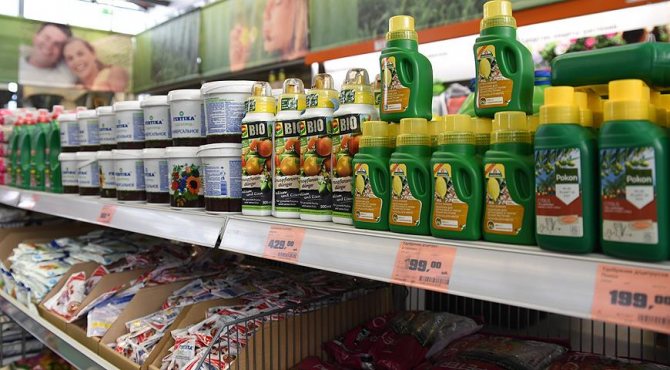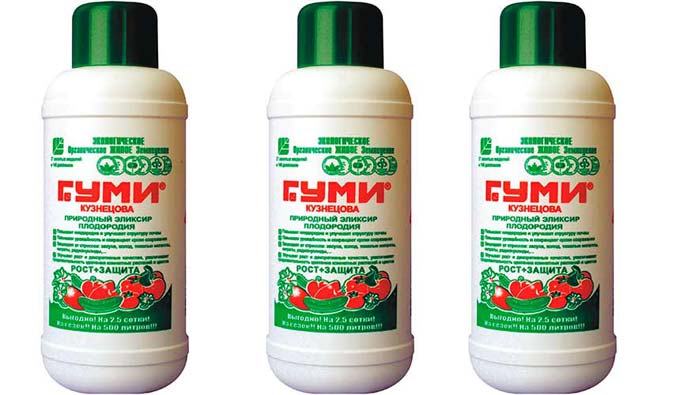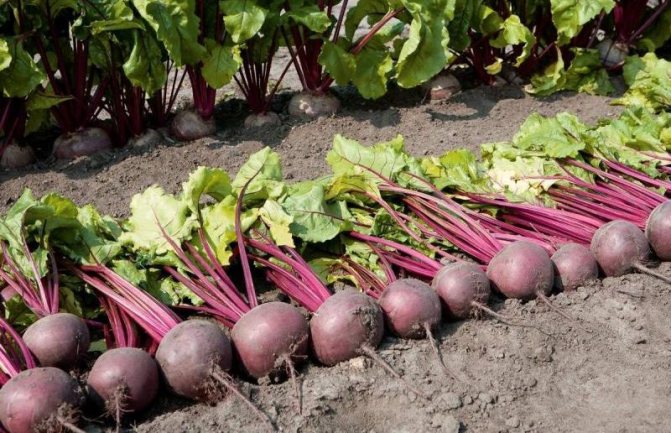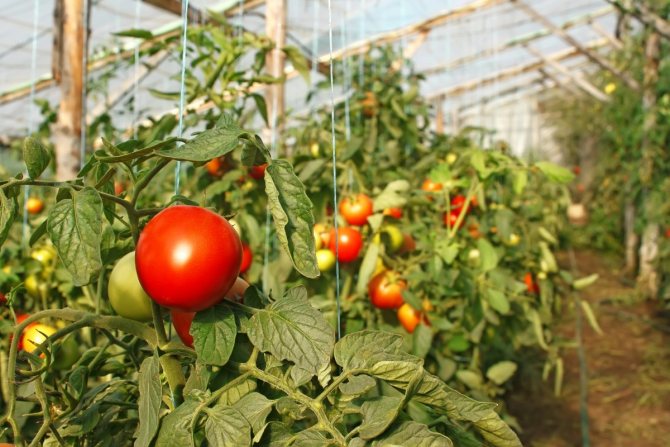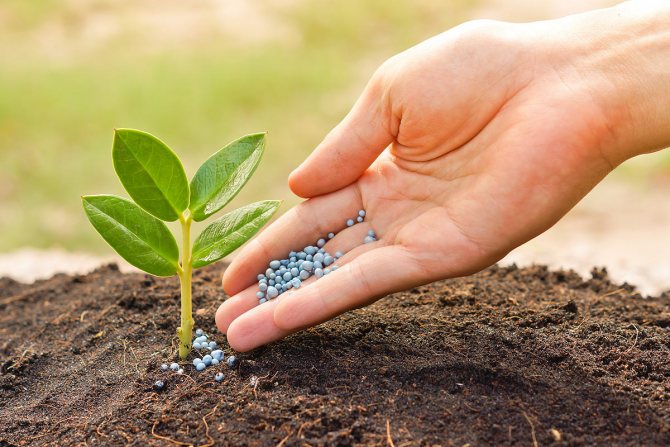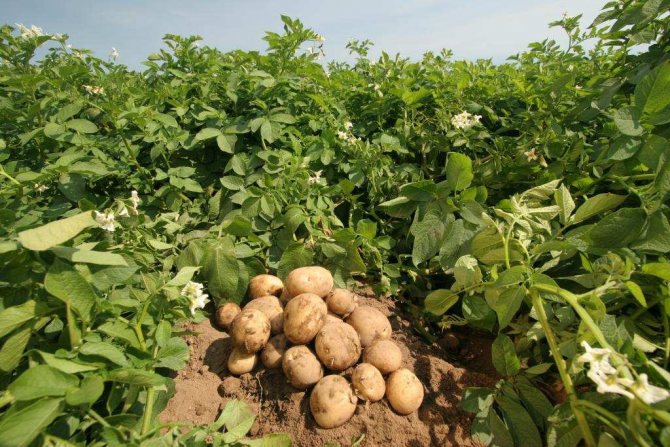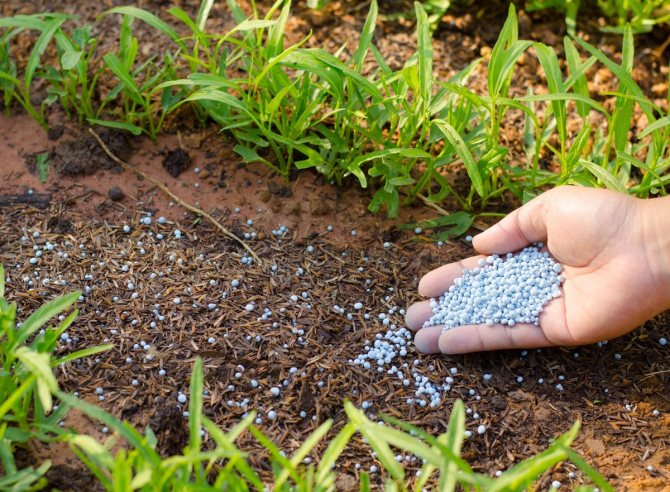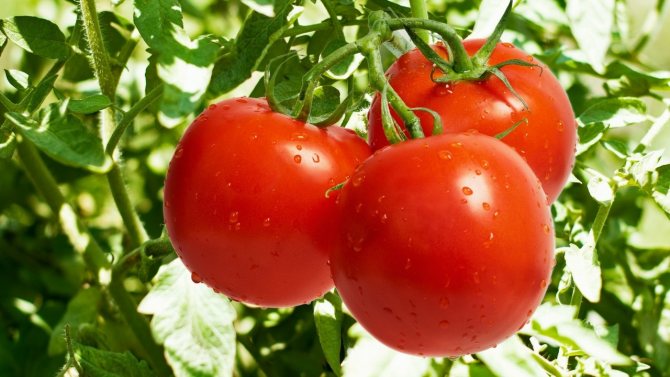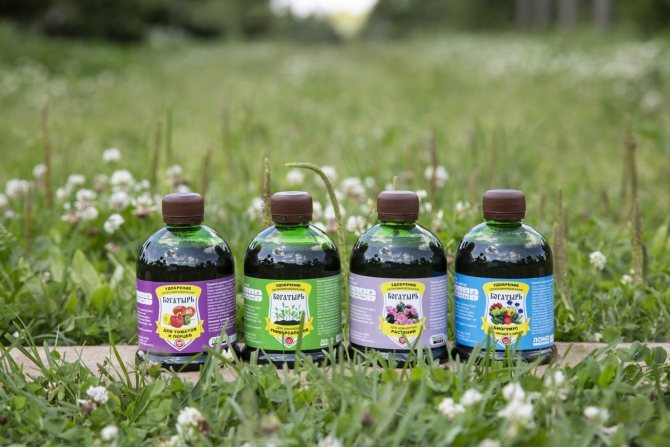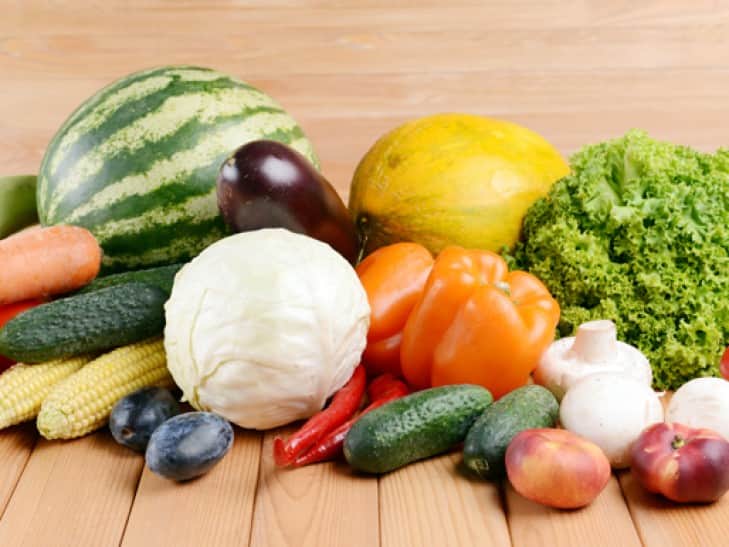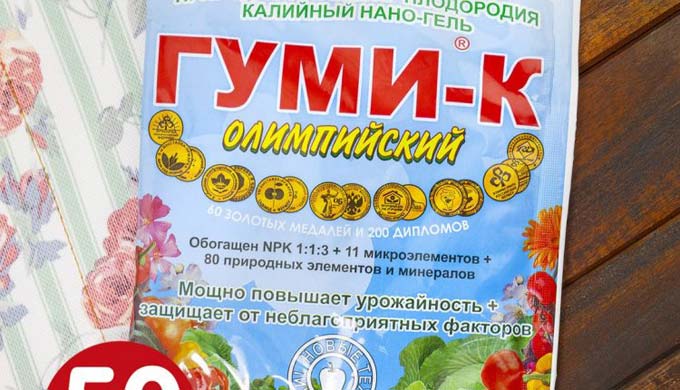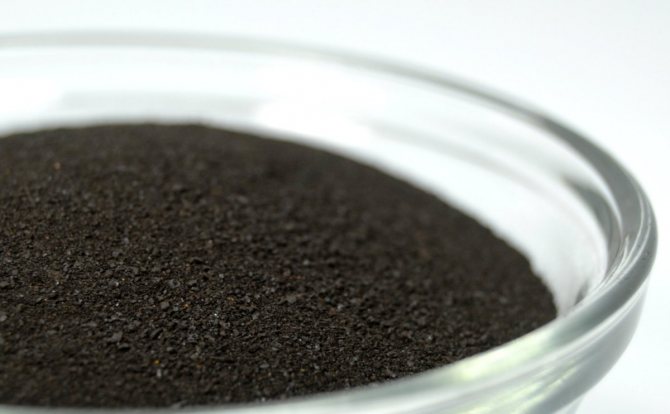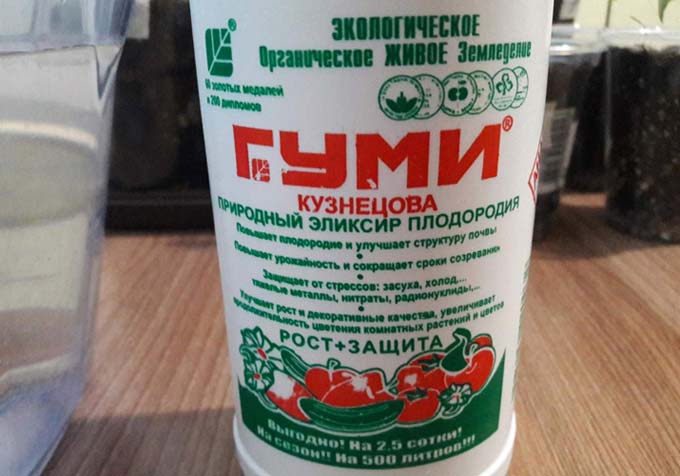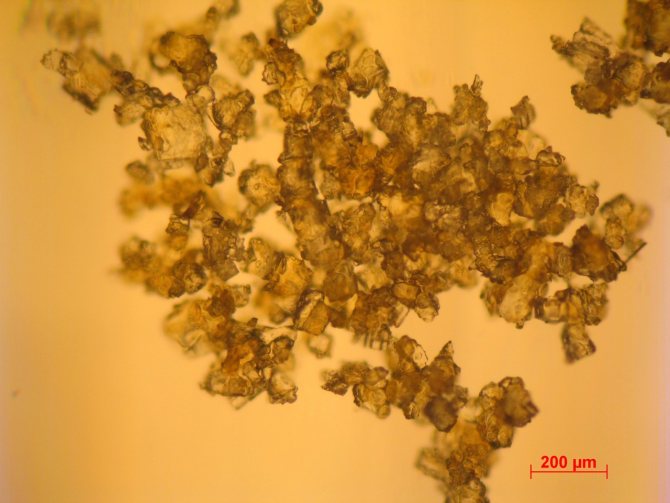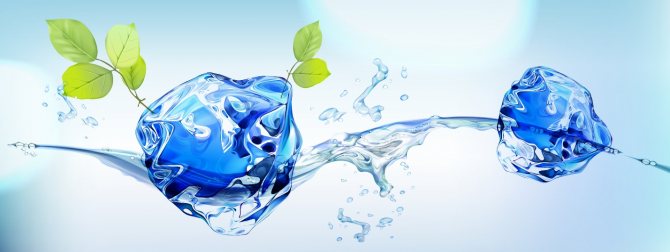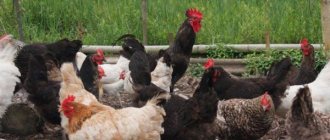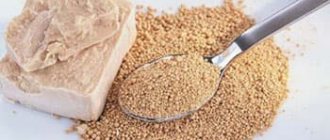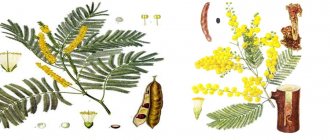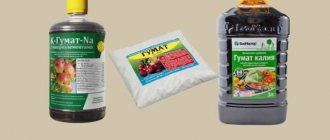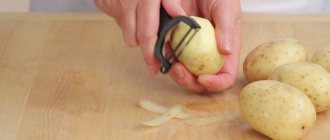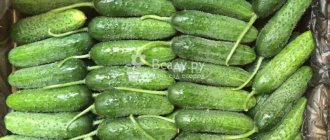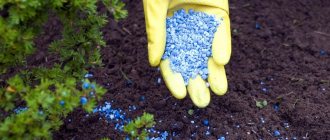Organic fertilizers nourish the soil with microelements, promote better development and growth of plant crops. Microorganisms that multiply in the soil, after a long time, release substances useful for plants.
A separate group of organic fertilizers is made up of humic fertilizers (GU). They are obtained from natural raw materials - peat, coal, silt. Their origin was preceded by decomposition over a rather long period of leaves, branches, root system, remains of animals, birds, microorganisms. In this way, they arise and undergo a process of accumulation in the soil.

They include humic acids, fulvic acids, their salts, as well as stable compounds with minerals in the soil. The regulatory function of humic acids is significant and multifaceted: it consists in stimulating the plant, improving the physical characteristics of the soil, chemical composition, and activating beneficial bacteria in the soil.
The value of Gumi fertilizer
The balanced composition of each type of Gumi fertilizer not only nourishes the aboveground mass, but also has a stimulating effect on the root system. The benefits of its use are as follows:
- It activates plant growth, while development does not lag behind. For this reason, Gumi has proven itself well for feeding seedlings.
- Resistance to stress from cold and drought increases.
- Accelerated yield formation due to faster adaptation of young plants.
- Increasing the yield due to the provision of the crop with the necessary amount of elements during the period of budding, fruit setting and the accumulation of reserve substances in the crop.
- An increase in the level of humus in the soil, which characterizes soil fertility.
- The susceptibility of plants to diseases and pests decreases.
What are humic acids and why do we need them?
Human immunity, its ability to resist viruses and bacteria depends on the presence of humic acids in the body. They are formed in the soil during the decomposition of plant residues.
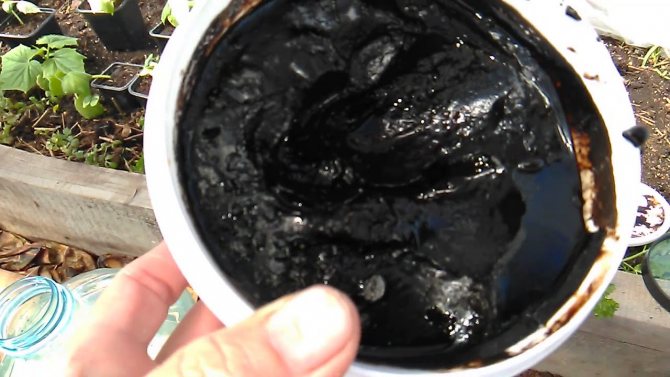

Scientists-agronomists, chemists, biologists have not yet figured out why vegetation does not decompose to end products - water and carbon dioxide, but at some stage turns into humic acids.
Getting into plants, and then into the human digestive tract, humates transfer a large amount of nutrients to the body: amino acids, vitamins, minerals, polyunsaturated fatty acids.
In a word - more than 70 useful components. When dissolved in water, humates structure it and make it similar to thawed thaw, which is known for its healing effect.
In fruits that are grown industrially, there are practically no humic acids, so they do not have the same strength and saturation with nutrients. The benefits of such products are minimal. Mineral fertilizers help crops grow, but they have no nutritional value.
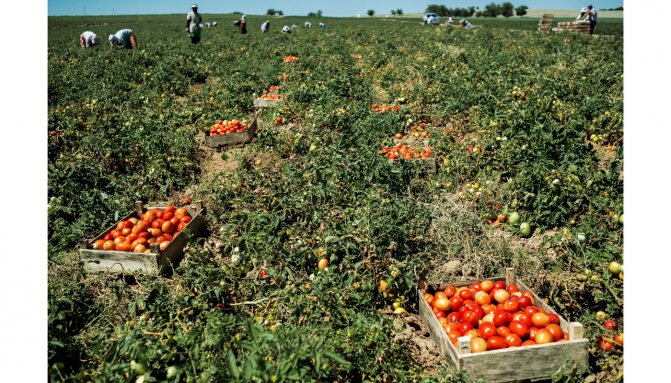

Fertilizer types Gumi
Fertilizer Gumi can be used on any crops, because the presence of the NPK complex, characteristic of the most common agrochemicals in agriculture, makes it possible to provide plants with everything necessary for normal development. Despite this, several types of the drug have been identified, depending on the object of application:
- Gumi-20.They produce such series as a station wagon with a standard ratio of macroelements (nitrogen and phosphorus 2% each, potassium half as much), rich vegetables, berries, greens with an increased percentage of potassium up to 3 and microelements necessary for these crops (copper, manganese, molybdenum, cobalt and etc). Gumi-20M with 3% nitrogen content is intended for street flowers and lawns. For indoor plants, the NPK-complex, on the contrary, is reduced to 0.5% of each element.
- Gumi-30. Contains a standard set of elements, but the concentration is higher. It is produced mainly in the form of a paste, which is diluted before use in water.
- Gumi-Omi. This type of fertilizer is distinguished by a large amount of nitrogen (13%) and a reduced amount of phosphorus and potassium (1 and 0.4%, respectively). It is designed to enrich composts and accelerate the maturation of organic matter.
- Lime Gumi with boron. Here the ratio of elements is much smaller compared to the others and amounts to 0.2: 0.4: 0.2. The composition of this solution is intended to improve the physiological properties of the soil, namely for salting acidic soils and enriching them.
Composition of Gumi preparations
The soil is depleted over time and needs to be enriched with nutrients. Various drugs are used to fill the deficit. Among the most demanded are Gumi. These are organic mineral fertilizers or fertilizers. They consist of micro and macro elements and various salts of humic acids.
The compositions of individual types of Gumi are different. First of all, it depends on which plants you need fertilization for, because certain elements are needed for different plants. For example, there is Gumi fertilizer used specifically for feeding strawberries.
However, the basic composition of this series of fertilizers is constant and contains:
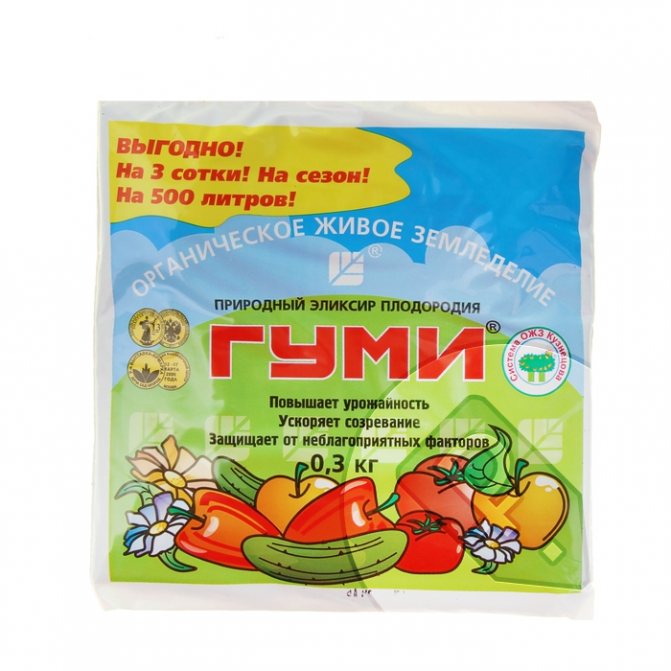

about 60% of salts of humic acids;- from 2% nitrogen. It is required for the full development of the plant;
- about 2% phosphorus, which is quickly absorbed by the flora;
- 1% potassium;
- also in the composition there is sodium, which, combining with potassium in the soil, improves the vitality of the flora. When the air temperature or humidity changes, plants do not respond to this by decreasing growth.
The fertilizer contains other useful substances. Together, they contribute to the development of plants from the beginning of the growing season to harvest.
Today humic dressings are widely used. For their creation, mostly exclusively natural components are used: organic matter of brown and bituminous coal, peat, bird droppings, horse manure, sapropel. They are washed out of the soil for a long time, have a protective property against diseases and enhance plant growth even in adverse conditions.
The drug Gumi Omi and its types is a unique growth biostimulant, which is due to the content of an active complex of mineral substances. They are completely safe for humans.
Application methods
Fertilizer Gumi can be used in several ways, and to achieve the best effect, it is recommended to combine several methods during the period of crop growth.
- Seed preparation. This operation can be carried out both in the form of soaking the seed material before sowing, and watering the beds when the seeds are already in the soil. This allows you to quickly awaken the dormant embryo and get earlier shoots. At the same time, young plants are actively developing, due to which the seedlings are strong, strong and healthy. For the same purpose, you can dip the tubers into the solution before planting and soak the cuttings.
- Watering seedlings before planting in a permanent place in the open field. This increases the resistance to stress and adaptability of crops.
- Top dressing for vegetation, root and leaf.
Effect on plants
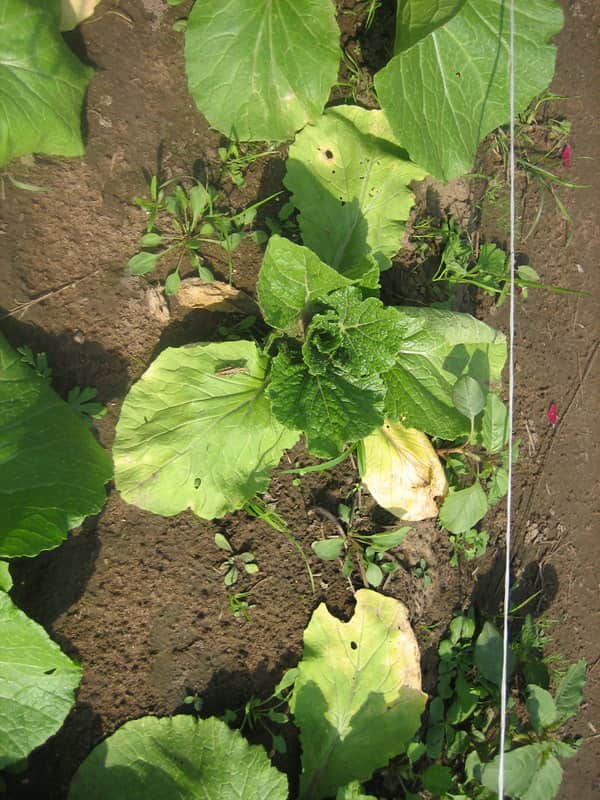

The acids contained in these preparations stimulate the growth and development of plants.Seeds soaked in water with humins for a day come off and germinate much better than seeds simply thrown into the soil, and each subsequent generation shows increased rates. Cuttings placed in a solution with humic substances root faster. In addition, their roots are stronger and longer.
Mature shrubs after fertilization grow faster and give higher yields. At the same time, the berries increase in size and their taste improves. A shortening of the ripening period is observed. In fruits, the content of ascorbic acid increases, and the amount of nitrates decreases.
One of the features of humic fertilizers is their equal effect on shrubs, regardless of weather conditions, be it drought, frost or constant rains. They also help plants recover from diseases or damage caused by excessive application of mineral fertilizers.
Instructions for use
The consumption rate for processing plants may vary depending on the type of fertilizer used and the crop being fed. In order to achieve maximum results, it is recommended to follow the instructions for use prescribed on the packaging.
- To increase fertility, 1 m2 of soil is enriched in autumn or spring with 10 liters of working solution (1.5 ml / l of water). For feeding, a composition with the same concentration is prepared. Moreover, if the plantings are watered from a watering can, then the consumption rate is 10 liters per 2 m2, and when spraying - per 1 hundred square meters.
- The seeds are treated with a composition of 2 ml of fertilizer and 0.1 l of water. The operation is carried out immediately before sowing. The same concentration is used for daily soaking of cuttings of fruit and berry crops before planting. The same norm is applicable for feeding indoor plants, which is carried out 2 times a month during the period of active growth.
- Potato tubers are treated with a solution prepared from 60 ml of Gumi and 1 liter of water.
The organic mineral fertilizer Gumi is an excellent product that combines the advantages of organic and mineral fertilizers. Today it has found well-deserved recognition among gardeners and gardeners, because it is easy to use, easy to store, and the results justify labor and cost. In addition, Gumi is not only safe for plants, but also belongs to low-hazard substances for humans.
- decrease in the body's immune defenses
- drowsiness
- frequent fatigue
- depression
- headaches, as well as various pains and spasms in the internal organs
If you feel frequent ailments, you just need to cleanse your body. How to do it
In order for the plants to grow actively and give good yields, it is very important to carry out timely and high-quality fertilizing with fertilizers. Such good nutrition is provided with an integrated approach, that is, the introduction of mineral, organic and bacterial additives. To make such "help" to fruit and ornamental crops only beneficial, it is important to know the timing and dosage of agrochemicals. This article will focus on organic plant nutrition - humic fertilizers.
Humic fertilizers belong to organic food, since they are based on manure, bird droppings, composts, peat and green foliage. Such "good" is in almost every household, therefore it is considered a local feeding. The task of organic acids is to fertilize the soil as much as possible in order to ultimately provide everything necessary for a high yield of agricultural and ornamental crops. Together with them, the soil receives all the necessary elements at the macro and micro levels.
Humic fertilizers have their own classification, however, they are united by the presence of humic acids in the base. Such fertilizers are formed in the process of complex biochemical decomposition of plant elements (leaves, roots and branches) and protein residues of animals.Every year, liquid humic fertilizers are gaining more and more popularity, since their composition is very close to mineral fertilizing, but there are an order of magnitude less nitrates in the soil after application. Such additives are produced in two forms:
- liquid complex formulations;
- granular formulations.
The most widespread among domestic agricultural technicians are liquid substances. They are actively used as large agricultural enterprises and farms, as well as owners of small household plots. The most popular are the following humic compositions:
Testimonials
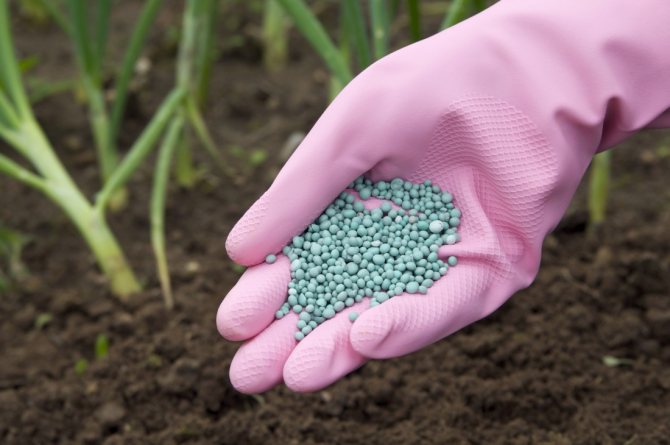

According to customer reviews, the advantages of fertilizer include:
- Increases the percentage of seed germination.
- Increases yield, crop immunity.
- Promotes the development of resistance of green spaces to adverse factors.
- It can be used to prevent various diseases.
- Improves soil structure, regulates air and moisture-absorbing exchange. The earth becomes looser, sufficiently moistened.
- Harmful impurities contained in the soil are not absorbed by the plant.
- Fertilizers based on humic acids help to accumulate vitamins, minerals, sugar, starch in fruits. This makes the harvest of plants treated with Gumi tastier than that obtained without the use of this product.
- Increases the shelf life of fruits, berries, vegetable fruits, flower buds.
- Stimulates the growth of seedlings and adult plantings.
- Harmless to people and the environment.
- Has an optimal price-quality ratio.
Relevance of use
Fertilizers actively affect plants, as:
- Potassium and a complex set of organic acids can radically affect the chemical and physical composition of the soil.
- Humates are ways to influence microorganisms, getting to the top of the culture.
- The metabolic processes in the soil are significantly improved, which means that the biological activity of plants in general increases.
- Humins - as a complex additive, can increase yields and maximize the fertility of depleted soils.
Preparation of working solution
For watering the soil, it is necessary to prepare a solution with a relatively low concentration of the active substance. The finished dressing should have a light brown tint. In this case, the optimal concentration of humate should be from 0.005 to 0.1%. It is worth noting that such a solution will not be able to meet all the needs of plants. Given such a concentration, they will lack zinc, nitrogen, phosphorus and other equally important elements. For this reason, experts recommend mixing humic potash fertilizer with additional mineral supplements. In this case, the traditional dosage can be reduced by half.
How to use correctly
Humic additives should be used even at the stage of seed treatment: seeds, tubers or cuttings.
Humic fertilizers are natural organic fertilizers that do not change for the worse the ecological purity, as well as the taste of our crop. Any representative of the flora needs proper, high-quality care. And if you want your pets to delight you with even greater beauty or an increased yield, then you should take care of high-quality feeding. Natural organics are definitely best. Let's talk about this.
Cultures indifferent to humates
Although humic fertilizers can be applied to the entire garden - there will definitely not be harm, but not all crops respond equally well to these substances. For example, all pumpkin seeds, legumes (beans and peas), sunflowers, corn do not show any particular increase in yield when humates are applied.
However, it is important to understand here that it is not so much a matter of culture, but of the conditions of its growth: for example, traditionally southern crops such as sunflower and corn, provided that they are grown on chernozem soils, do not need abundant fertilizing - black soil is so fertile.


An excellent harvest will grow on fertile soils even without humic fertilizers
Humic fertilizers theory and practice of their application
This type of fertilizer has a wide range of applications, high efficiency, proven by many agricultural industries, which began to use humates in growing vegetables and fruits in order to improve the quantity and quality of their products.
Everyone should think about using this type of dressing on personal subsidiary plots, orchards, orchards. Humic fertilizers can be used:
- When growing flowers, ornamental plants:
- for rooting cuttings, processing tubers, bulbs, as a stimulant for the development of the root system;
- to relieve stress in plants, their nutrition after transplantation; for feeding adult specimens during growth, flowering.
- When growing seedlings:
- for soaking seeds before sowing;
- for foliar and root feeding of seedlings.
- When growing vegetables, berry crops:
- for root and foliar feeding of plants during all periods of development;
- to relieve stress after adverse weather conditions (frost, drought);
- to protect plants from bacterial and fungal diseases.
- When caring for an orchard:
- for feeding or relieving stress in seedlings during transplantation;
- to improve the quality of the soil near-trunk circles.
- When processing the soil after harvest, in preparation for a new sowing.
- As a compost maturation accelerator.
Thus, it becomes clear that the use of humic fertilizers is possible at all stages of plant formation, development, and growth. This makes them unique, fully in demand when growing almost any crop in orchards and vegetable gardens.
During the dilution of the concentrate, it is necessary to strictly observe the proportions, which must be indicated on the packages or in the attached instructions. Never exceed dosage: an increase in allowable rates can inhibit growth or fruiting. Depending on the type of plant and the necessary manipulation with it, the concentration of the solution varies greatly. It should be remembered that the finished solution of the drug is stored for no more than a week.
The use of humic fertilizers is especially appropriate in areas with sharp temperature changes, changes in meteorological conditions, since the drug increases the resistance of plants to environmental factors, and also makes perennials, shrubs, young trees more winter-hardy.
Potassium humate
The result of fertilizing barley with potassium humate
It is a liquid fertilizer. It contains many useful substances: humic acids, nitrogen, phosphorus, potassium, calcium, magnesium. It also contains some trace elements: boron, molybdenum, manganese, zinc, copper, cobalt. It is a slightly alkaline solution.
This is a complex preparation, the main component of which is represented by sapropel extract. Provides adequate nutrition for plants. It is used for growing environmentally friendly products. Promotes the rapid assimilation of the components of mineral fertilizers.
Potassium humate is used for seed treatment before planting and plant feeding during the growing season. It saturates the plant with all the necessary substances and trace elements, accelerates their growth and increases resistance to diseases and low temperatures.
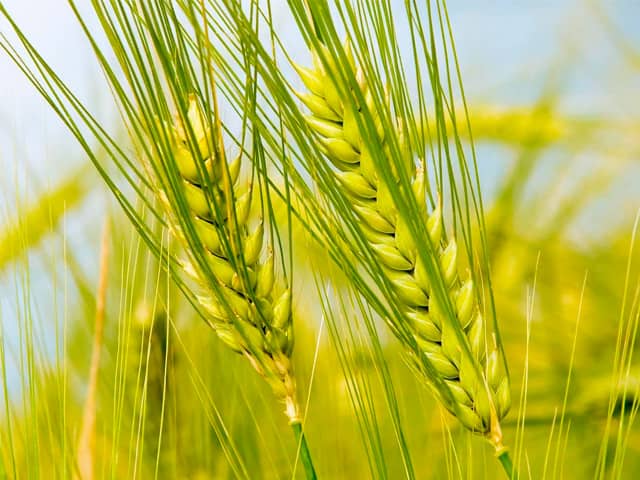

Fertilize the soil and sprouts will not keep you waiting
For 24 hours before planting, the seeds are soaked in a solution that consists of 1 liter of water and 20 ml of fertilizer. Bulbs and tubers are kept in the same solution for 1-3 hours. The cuttings are kept for 12 hours. For spraying the bushes, 5-20 ml of potassium humate is dissolved in 1 liter of water.Spraying is carried out in the morning or in the evening. For root feeding, a 1-2% solution is used.
Composition of humic fertilizers
Most gum concentrates are available in liquid form, which is very convenient for use. As a rule, it is a slightly viscous liquid, dark brown in color, with a mild odor. The balanced composition of the preparation contains nutrients of natural origin. After all, humates are produced on the basis of organic raw materials. These are manure or plant composts, sapropel, brown coal, silt.
Natural organic compounds - humic acids (humic and fulvic acids) are released from the above-mentioned products of plant, microbial or animal origin by exposing them to alkaline solutions.
The main unique composition of humic fertilizers is:
- humic acids,
- fulvic acids,
- amino acids (Arginine, Histidine, B-phenylallonine, Proline, etc.).
Many formulations contain beneficial microorganisms (amonifiers), mushrooms, as well as a complex of macro- and microelements (magnesium, potassium, sodium, calcium, iron, phosphorus, nitrogen, zinc, etc.).
![]()
![]()
Varieties - refined and unrefined fertilizers
Pure humic fertilizers are a highly concentrated product isolated from plant deposits. A small amount is enough to dilute with water and water the entire area. They are also called drugs.
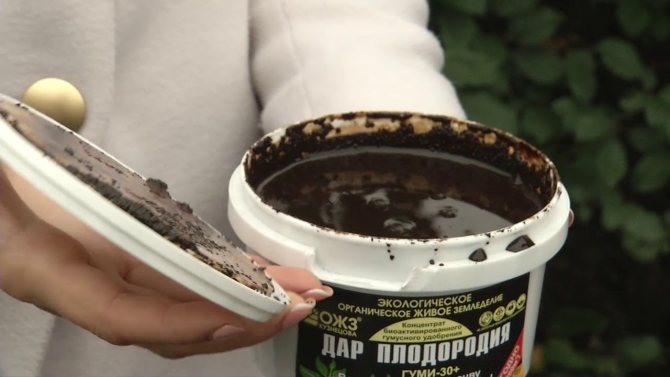

Natural deposits are considered unrefined - peat, silt, brown coal. They contain a large amount of ballast substances. Ballast is an additional plant mass in which humic fertilizer is retained. When they enter the soil, soil microorganisms begin to gradually process organic matter and mineralize the ions of useful nutrients, after which they enter the plant tissues.
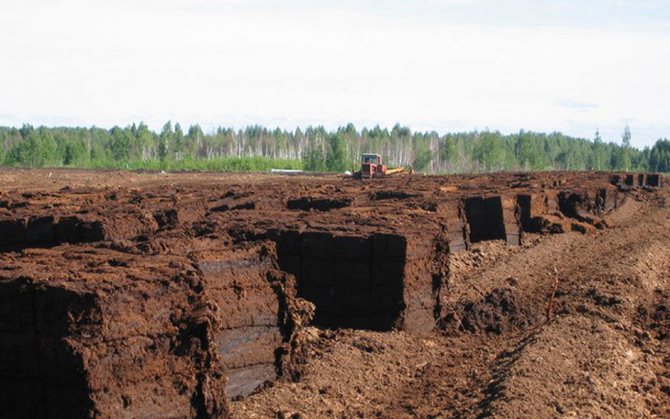

This process takes time, so unrefined humic fertilizers are used in autumn. They are embedded in the soil and await spring. During the winter, bacteria partially cope with the volume of organic matter, so in the spring the soil becomes more fertile.
You can get a useful extract from cellulose and fallen leaves, subjecting them to appropriate processing.
Types of humic fertilizers
The classification of humic fertilizers is quite extensive, among the products there are growth stimulants, top dressing, compost maturation accelerators, soil enrichments. For example, GumiOmi Compostin helps to accelerate the maturation of compost, enriches it with nutritious gumi, improves microflora, which accelerates the maturation of compost. This organomineral gumio fertilizer is based on chicken manure with a high nitrogen content. With the help of beneficial bacteria, it treats the compost composition or soil from fungal diseases, destroys harmful bacteria, and reduces the content of heavy metals or toxic substances.
Liquid humic fertilizers
Liquid humic fertilizer is a natural immunomodulator, stimulator of plant formation, growth, development, antistressant, as well as complete feeding. Example: Edogum SM, Zhivaya Strelka, Garden of Miracles, Ekorost, Delight, etc. It is used at all stages of growth, from seed treatment before sowing to soil treatment after harvest. Suitable for organic farming.
Soft humic potash fertilizers effectively stimulate the formation and growth of roots. They are used for pre-sowing treatment of seeds, tubers, bulbs, and for cuttings. For example, an organo-mineral fertilizer with microelements GUMI-OMI for bulbous, corms can be applied when planting in a hole, or can be used for fertilizing irrigation.
Gumi-omi based on chicken manure
Any humic potash fertilizer also has a broad spectrum of action if trace elements are included in its composition.In addition to stimulating the growth of the root system, the product of agrochemistry enhances the plant's immunity.
Very famous are Gumi-20 Potassium, Gumi-20M Potassium, Liquid Peat Potassium Humate, Potassium Humate +7 and others.
Peat-humic fertilizers
Peat-humic fertilizers are produced on the basis of peat raw materials.
One of them - Flora-S - is used in the processing of seed material (seeds, bulbs, root crops, roots of seedlings, herbal plants), for root or foliar feeding of vegetable crops, fruit trees, shrubs, vineyards.
The peat-humic preparation Gumimax is an excellent product for the care of indoor flower and ornamental plants. It contains folic and humic acids. Stimulates the growth of the root system, the aboveground part of plants, rejuvenates old plants, promotes lush, long flowering.
The updated preparation Fitop-Flora-S (dry peat-humic fertilizer) fights against putrefactive, pathogenic microflora in the soil, is used in the processing of cellars, storage facilities, even the harvested crop. It is believed that peat-based humic fertilizer is the most useful and effective in agricultural production.
Efficiency on different types of soil
Like any other fertilizers, humic preparations act differently on different types of soil. Their properties are best manifested on "poor" soils, especially sod-podzolic soils. They loosen such soil, enhance the reproduction of beneficial bacteria and make it more susceptible to the subsequent introduction of nutrient mineral components. Humines have proven themselves as good as possible on soils containing little humus. In addition, this fertilizer is suitable for soils that have been vigorously planted for many years, without giving the land a rest. The weakest effect of fertilization is shown on chernozems.
Application for garden and horticultural crops
As we have already indicated, thanks to the use of humic fertilizers, it is possible to significantly increase the germination of seeds and increase the yield of a wide variety of plants.
Humic fertilizers are suitable for enriching any type of soil and for fertilizing the vast majority of crops, especially those growing on compacted soils such as clayey. It is especially recommended to apply humic fertilizers when transplanting seedlings, with a large amount of precipitation during the growing season, as well as with late spring frosts and in those summer cottages where timely or sufficient watering is not always sufficient.
As a foliar top dressing, most often, a 0.1% solution of humic fertilizer is used; for introduction into the soil, a 0.2% solution of this substance can be used. The main thing is that when dissolving the concentrate of humic fertilizer, it is necessary to use water at room temperature, not lower than +15 degrees, but not higher than +40 degrees. The humic fertilizer (without sediment) dissolves best of all in soft water, that is, rain, thawed or settled water.
On vegetable crops (especially during wet seasons), humic fertilization can significantly reduce the risk of diseases such as rot, late blight, scab, as well as a whole group of other fungal and bacterial diseases.
Read more about the use of humic fertilizers on the most common crops.
Cucumbers, squash, zucchini
As for these vegetable crops, it is permissible to apply humic fertilizers under them throughout the season, respectively, at any stages of development of these plants. The greatest effect is noticeable when humic fertilizers are applied during untimely cold snaps or in too humid years, that is, during an unfavorable period that can lead to a decrease in yield.
Presowing treatment with humic fertilizers and seed is quite acceptable, for example, soaking in a 0.05% solution for a day.After such soaking, as a rule, the rate of seed germination increases, the activity of seedling emergence, the seedlings grow well and have an increased immunity to various kinds of infections. The technology of pre-sowing preparation of seeds of these crops must necessarily include drying after soaking and germination by traditional methods.
During the period of growth and development of seedlings of these crops, it is permissible to add a 0.1% solution of humic fertilizer to the soil at a dose of 250-300 g per square meter. By fertilizing the soil in this way, the total number of "under-catch" (small, weak seedlings) is reduced, as well as the resistance of the seedlings to the blackleg increases and possible mistakes in the care of the seedlings are leveled.
Top dressing in the soil can be alternated with foliar dressing, for example, fertilize the soil once a week, and the next time, the next week, also once, spray the plants with fertilizer in the same concentration, but spending about 25-30 g of solution for each plant ...
Treatment of these plants with a 0.1% solution of humic fertilizer during the budding period will help to reduce the number of "barren flowers". After treatment of plants with humic fertilizers, as a rule, more even fruits are formed, and fruits of an atypical form for the variety either do not exist at all, or there is an extremely small amount of them (no more than 1%).
When processing cucumbers in years that are too rich in rains, half the norm of any permitted fungicide can be added to the preparation, thus preventive treatments against powdery mildew can be carried out.
Tomatoes, eggplants, peppers, potatoes
These crops respond well to humic fertilization. Considering that plants are very demanding on the presence of sufficient amounts of potassium and nitrogen in the soil, humic fertilizers will increase the absorption of these elements by the root system. Simultaneously with humic fertilizers, other potash fertilizers must be applied for these crops, because they really need potassium, especially tomatoes.
Given the complexity of humic fertilizers, when using them, it is desirable to reduce the dose of basic fertilizers by half, especially nitrogen and phosphorus fertilizers.
It is also possible to start applying humic fertilizers to these crops with pre-sowing seed preparation. The seeds are soaked in a 0.05% solution of humic fertilizers for 24 hours, after which it is permissible to germinate them without drying. Soaking the seeds of these crops in a solution of humic fertilizers accelerates their germination by 2-3 days, enhances the germination activity and reduces the number of plants that form a weak root system.
Before planting seedlings, it can be treated with 0.1% humic fertilizer, spending 35-40 g of solution for each plant. Such seedlings, as a rule, get sick less after transplanting and start growing faster.
In the future, at the beginning of the "fattening" of the shoots, it is necessary to completely stop the application of humic fertilizers under the root and carry out only foliar dressing, that is, spray the plants themselves.
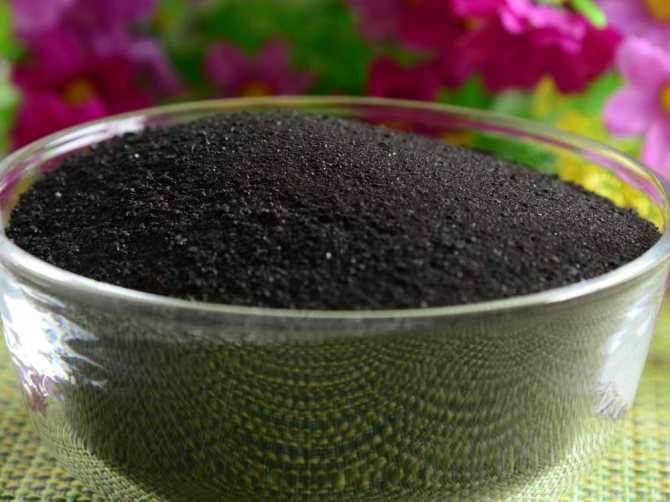

Currently, in addition to liquid, humates are produced in the form of a paste or powder (granules). <>
Corn, sunflower, legumes
The effect of using humic fertilizers for these plants is usually almost invisible. It is noticeable if you apply humic fertilizers and treat weakened plants with them, as well as soak the seed material before sowing (0.1% fertilizer for 24 hours).
Trees
In relation to tree crops, it is appropriate to apply not fertilizing under the roots, but foliar dressing, that is, processing the leaf mass of plants. In this case, the concentration of the solution can be increased to 1%. Trees respond best to foliar feeding with peat-humic fertilizers.
Thanks to foliar feeding with humic fertilizers, the number of ovaries in tree crops increases, usually by 25-30%, and it crumbles less. It is not necessary to carry out a single treatment, for a greater effect it is better to carry out treatments up to the beginning of the harvest, treating the plants once every 20-25 days, starting from the budding phase.
It is quite acceptable, and in the case of weakened seedlings, it is strongly recommended that humic fertilizers be applied to the planting hole when placing seedlings in it both in autumn and in spring. Here you need to use increased doses of fertilizer (5-10%) and pour two or three liters of such a solution into each hole. Then, as soon as the seedling forms leaf blades, foliar dressing (0.1-0.2% solution) can be carried out throughout the growing season.
The use of humic fertilizers on soils contaminated with heavy metals and other chemical substances is quite justified. Their use will make it possible to level the amount of harmful substances in fruits and even improve their taste.
Shrubs
The maximum effect of humic fertilizers in relation to shrubs is achieved when they are used as an increase in the resistance of various species to late spring return frosts. The effect of foliar feeding with a 0.5% solution of humic fertilizer on currants, gooseberries and, to a lesser extent, on other shrubs has been proven.
The very first treatment is appropriate in early spring, as soon as the buds begin to bloom. During this period, it is better to apply fertilizer under the roots, distributing about 5-6 liters of a 0.1% solution in the bite zone. After applying this fertilizer, it is advisable to water the soil, and if you want everything to be perfect, then loosen the soil before applying fertilizer, then water it, and then mulch it with humus - with a layer of one centimeter.
With the normal development of shrubs, fertilizers can not be applied before flowering, but at this time they can be applied in the same doses as above. Then you can feed the shrubs during the formation of ovaries and the final time - in the autumn, before the foliage begins to fall.
Flowers
For flower crops, humic fertilizers are applied in order to increase the general decorativeness of plants, increase the period of flowering and the formation of a larger number of buds. Flower crops in pots are watered with 0.05% fertilizer so that they develop stronger and can withstand even long-term transportation before planting on the site.
In addition, this fertilizer can be used when propagating flower crops (for example, roses) with green cuttings. To do this, before planting the cuttings in a greenhouse covered with a film, it is necessary to place them vertically in a 0.5% fertilizer solution after cutting, so that a third of the cuttings is immersed in the composition. You can soak the cuttings from 12 to 24 hours, usually, the warmer it is in the room where the cuttings are soaked, the shorter the soaking period should be, so at + 30 ° C 12 hours are enough, at + 15 ° C 24 hours are needed.
In addition, bulbs and tubers can be soaked in 0.25% solution of humic fertilizers before planting, this contributes to more active plant growth and their earlier flowering (from 3-4 days to one and a half weeks). In addition, soaking tubers for an hour in such a solution helps to reduce the likelihood of rot by 70%. If you want to reduce the likelihood of rot by 95%, then add any approved fungicide to the solution.
That's all we wanted to tell you about humic fertilizers, if you don't understand something or have questions, then write them in the comments, we will be happy to answer them.
Act
The study of humic substances has been going on for more than two centuries (since 1786, Franz Aschar, Germany), but only in the late 80s - early 90s of the last century was their ability to prevent the intake of heavy metals and radionuclides from the plant reliably established. What prompted the start of mass production of humic fertilizers and humates separately.
The main decomposition products of humin in the soil are humic and fulvic acids. Under natural conditions, their compounds either leach rather quickly (for example, when the fallen leaves overheat), or, being buried in the soil, over geological periods of time turn into bitumens and coals (brown, then stone and anthracite). By introducing concentrated humin into the soil, we provoke a "volley" of soil acids.
The roles of humic and fulvic acids in soil are polar opposite. Both readily form chelating compounds, but their fate is further determined by the solubility of the starting acids.
Humic acids are insoluble in acidic media (at pH <2). In weakly acidic and neutral soluble to a limited extent. Well soluble in alkaline media; their industrial production is based on this: shredded wood waste is processed into lignosulfonate, which is simple and inexpensive, and it is treated with a weak alkali solution, into which humic compounds pass.
In the soil, humic acids greedily “grab” metal and ammonium ions, incl. received with an excess of mineral fertilizers. The formed chelates remain in place for a long time, because fertile soil environment is quite acidic. However, humic acids are "indifferent" to phosphorus, therefore the use of humates does not save one from an excess of phosphates.
When the soil is alkalized, humic chelates begin to disintegrate, feeding the plants evenly and maintaining the pH of the medium, which prevents its destruction and contributes to the preservation of the soil biocenosis. If dry peat humin is introduced into the dead soil, then living foci are formed in it, then spreading to the entire mass of the soil.
Note: about the action of humates, see the video:
Video: about humates and their action
Fulvic acids are highly soluble in humid environments with almost any pH, and therefore they easily migrate in the soil. Under normal conditions, without excessive moisture, it is fulvic acids that ensure the uniformity of the chemical composition and structure of the soil. On sands - they help to tighten the pores between grains of sand; on clays, on the contrary, their loosening, an increase in permeability and exchangeable moisture capacity.
If the soil is oversaturated with heavy metals (including radioactive ones), then, according to the laws of chemical equilibrium, the formation of their fulvic chelates increases. Further, due to the high solubility of fulvates, they migrate quickly and far. This may in itself give rise to an environmental problem, but much less foreign matter will get into this year's crop in this area.
Note: Insoluble residues of many pesticides are neutralized by fulvic acids in a similar manner, but without chelating.
Features of the action
The described properties also explain the features of the action of certain types of humic fertilizers:
- Dry peat humin is universal, so long as the soil is not waterlogged: depending on its properties, according to the same laws of chemical equilibrium, the decomposition of humin shifts towards either humates or fulvates, as a result of which soil fertility increases;
- Sapropel humin is initially over-enriched in fulvates, because the bed of the lake due to the so-called. colmatation is not very permeable to moisture. In loose, leached soils, also according to the laws of chemical equilibrium, the natural decomposition of dead organic matter occurs with a shift to fulvates. The introduction of humic fertilizer gives a "fulvate salvo".The balance shifts towards humates, which reduces the permeability of the soil, leaching, and then its composition is normalized;
- Liquid humic fertilizer "intercepts" excess nutrients and then gradually releases it during the season. Losses of nutrients are reduced by an order of magnitude, and plants do not suffer from their overdose. The likelihood of accumulation of nitrates in fruits decreases significantly.
Note: about the restoration of soil fertility with the help of humic fertilizers, see the video:

